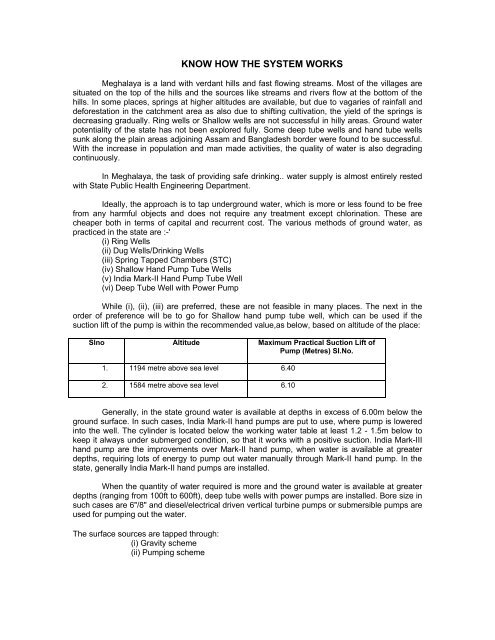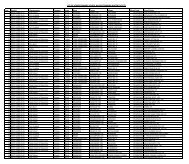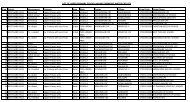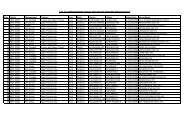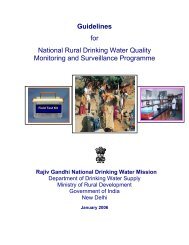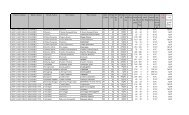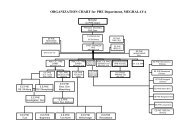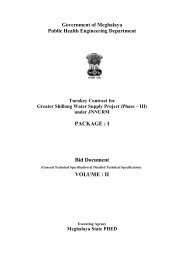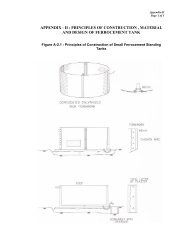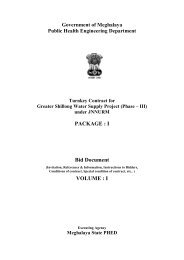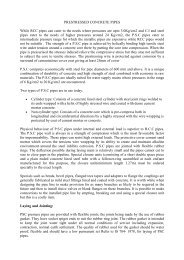KNOW HOW THE SYSTEM WORKS - Public Health Engineering
KNOW HOW THE SYSTEM WORKS - Public Health Engineering
KNOW HOW THE SYSTEM WORKS - Public Health Engineering
Create successful ePaper yourself
Turn your PDF publications into a flip-book with our unique Google optimized e-Paper software.
<strong>KNOW</strong> <strong>HOW</strong> <strong>THE</strong> <strong>SYSTEM</strong> <strong>WORKS</strong><br />
Meghalaya is a land with verdant hills and fast flowing streams. Most of the villages are<br />
situated on the top of the hills and the sources like streams and rivers flow at the bottom of the<br />
hills. In some places, springs at higher altitudes are available, but due to vagaries of rainfall and<br />
deforestation in the catchment area as also due to shifting cultivation, the yield of the springs is<br />
decreasing gradually. Ring wells or Shallow wells are not successful in hilly areas. Ground water<br />
potentiality of the state has not been explored fully. Some deep tube wells and hand tube wells<br />
sunk along the plain areas adjoining Assam and Bangladesh border were found to be successful.<br />
With the increase in population and man made activities, the quality of water is also degrading<br />
continuously.<br />
In Meghalaya, the task of providing safe drinking.. water supply is almost entirely rested<br />
with State <strong>Public</strong> <strong>Health</strong> <strong>Engineering</strong> Department.<br />
Ideally, the approach is to tap underground water, which is more or less found to be free<br />
from any harmful objects and does not require any treatment except chlorination. These are<br />
cheaper both in terms of capital and recurrent cost. The various methods of ground water, as<br />
practiced in the state are :-'<br />
(i) Ring Wells<br />
(ii) Dug Wells/Drinking Wells<br />
(iii) Spring Tapped Chambers (STC)<br />
(iv) Shallow Hand Pump Tube Wells<br />
(v) India Mark-II Hand Pump Tube Well<br />
(vi) Deep Tube Well with Power Pump<br />
While (i), (ii), (iii) are preferred, these are not feasible in many places. The next in the<br />
order of preference will be to go for Shallow hand pump tube well, which can be used if the<br />
suction lift of the pump is within the recommended value,as below, based on altitude of the place:<br />
Slno Altitude<br />
1.<br />
2.<br />
1194 metre above sea level<br />
1584 metre above sea level<br />
Maximum Practical Suction Lift of<br />
Pump (Metres) SI.No.<br />
Generally, in the state ground water is available at depths in excess of 6.00m below the<br />
ground surface. In such cases, India Mark-II hand pumps are put to use, where pump is lowered<br />
into the well. The cylinder is located below the working water table at least 1.2 - 1.5m below to<br />
keep it always under submerged condition, so that it works with a positive suction. India Mark-III<br />
hand pump are the improvements over Mark-II hand pump, when water is available at greater<br />
depths, requiring lots of energy to pump out water manually through Mark-II hand pump. In the<br />
state, generally India Mark-II hand pumps are installed.<br />
When the quantity of water required is more and the ground water is available at greater<br />
depths (ranging from 100ft to 600ft), deep tube wells with power pumps are installed. Bore size in<br />
such cases are 6"/8" and diesel/electrical driven vertical turbine pumps or submersible pumps are<br />
used for pumping out the water.<br />
The surface sources are tapped through:<br />
(i) Gravity scheme<br />
(ii) Pumping scheme<br />
6.40<br />
6.10
Except for spring sources, treatment of water is generally necessary for such schemes.<br />
When we talk about water treatment, the term 'filtration' comes automatically. Water treatment is<br />
a physical-chemical process for separating suspended and colloidal impurities from water by<br />
passage through a granular material. Over the years, the meaning of the word 'filtration' as used<br />
by the water works industry has changed. In 1800s, the slow sand filter was dominant. It<br />
incorporated sand with an effective size of 0.2mm. This very fine sand produced good quality<br />
water from applied water of low turbidity at rates on the order of 0.12 to 0.32 m/h of bed area.<br />
Because of the low surface rates, slow sand filters required large areas of land. The<br />
removal of impurities takes place by following mechanism:<br />
1. The attachment and absorption of particles preset in water to the surface of sand<br />
grains.<br />
2. Retention of particles larger than the pores of the granular medium, known as staining.<br />
3. Formation of a layer of organic materials and other nutrients present in water at the top<br />
of the sand bed, known as 'Schmutzdecke', that efficiently strains very minute particles.<br />
When the quantity of effluent water becomes very less due to deposit of excessive<br />
impurities, it is cleaned generally once in 2-3 months, by scrapping top 2-3 cm of schmutzdecke<br />
manually.<br />
In early 1900s under the stimulus of epidemic water borne disease, the rapid sand filter<br />
came into general use and it largely replaced the slow sand filter. Rapid sand filter media might<br />
vary in effective size from 0.35 to 1.00mm with a typical value being 0.5mm with an uniformity coefficient<br />
of 1.3 to 1.7. This type of media has demonstrated the ability to handle applied turbidity<br />
of 5 through 10 NTU at rates up to 4.88 m/h. Sand being bigger in size than the slow sand filter,<br />
rate of filtration is much higher (approx. 20 times) in rapid gravity filter requiring less space than<br />
the slow sand filter in treating the same quantity of water. The pore opening in a rapid gravity filter<br />
ranges from 0.1 mm to 0.2mm in size. In the water applied to the filter, floc size ranges from 2mm<br />
to less than 0.1 mm. It follows from these dimensions that the large floc particles can be removed<br />
by simple staining of the filter surface, but that much of the flocculated matter will pass into the<br />
filter bed and lodge within it largely in the top 10cm of the sand bed. The rapid sand filter requires<br />
cleaning generally once in 24 hrs. as against 2/3 months for a slow sand filter.<br />
Rapid sand filters are cleansed by reversing the flow through the filter and backwashing<br />
the trapped particles from the bed. After back washing, the very fine sand accumulates at the top<br />
of the bed and the coarser particles lie below. More than 90% of the particles removed are taken<br />
out in the top few cm of the bed. Once a suspended particle has penetrated this top layer of the<br />
fine sand, its chances are greatly increased for passing through the entire bed, because the void<br />
spaces become larger and opportunities for contact decrease, as the particles travel downward.<br />
This is a well recognized limitation of the rapid sand filter.<br />
In conventional filters, narrated above, water is passed from fine to coarse sand grains,<br />
leaving a lot of void space unutilized. If the filter media could be fully utilized, the filter run would<br />
have been more, the filtration rate would increase, improving both quality and quantity of filtered<br />
water.<br />
First attempt of coarse to fine filtration was by reversing the flow of water from bottom to<br />
top in Up Flow Filtration. This removed the shortcomings of conventional filters, but if the<br />
adequate attention is not given for timely cleaning, previously removed particles trapped in the<br />
bed could escape in the- effluent, giving rise to quality problem.<br />
It was not until early 1940s, the development of coarse to fine principle of filtration took<br />
place, resulting in introduction of mixed media filter units, where three materials coal, sand and<br />
garnet/ilmenite having specific gravities of 1.4, 2.65 and 4.5 with coal at the top, sand at the<br />
middle and garnet/ilmenite at the bottom are placed. The particles are sized in such a way that<br />
after backwashing, controlled intermixing of these materials occur and no discrete interface exists<br />
between them. With applied turbidity of less than 15 NTU, dual media filters can operate under<br />
steady state condition at 9.76 to 12.2 m/h with production of high quality water. Thus the filtration
ate in mixed media filter is approx 2 to 3 times higher than the rapid gravity filter and 40 to 60<br />
times higher than the slow sand filter. However, if the raw water contains excessive amount of<br />
finer particles, quality problem of filter effluents is encountered. Such type of filters have been<br />
constructed in the state with modification in simplified water treatment plants.<br />
Some of the major Water Supply Schemes, where Slow Sand Filters and Rapid Gravity<br />
Filters have been constructed for drinking water purposes are :<br />
SLOW SAND FILTERS<br />
(i) Umkhen W.S.S. (for Shillong Area)<br />
(ii) Dalu W.S.S. preceded by a UPFLOW FILTER<br />
(iii) Baghmara W.S.S. preceded by a UPFLOW FILTER<br />
(iv) Rajasimla W.S.S.<br />
(v) Chibonga IN.S.S<br />
(vi) Wage Asi W.S.S.<br />
RAPID GRAVITY FILTERS<br />
(i) . Greater Shil!ong Water Supply Scheme (G.S.W.S.S.) Phase-I, Capacity-7.5<br />
MGD.<br />
(ii) Tura Phase-II W.S.S, Capacity-3.6 MGD.<br />
(iii) Jowai W.S.S., Capacity-1.50 MGD.<br />
(iv) Mawlai W.S.S., Capacity-0.75 MGD.<br />
(v) Simsanggiri W.S.S., Capacity-O.75 MGD.<br />
(vi) Baghmara Civil Sub Divn. Complex W.S.S.<br />
(vii) Nongpoh W.S.S.<br />
(viii) Mairang W.S.S.<br />
(ix) Maulakandi W.S.S.<br />
The simplified treatment plant is a new technique, developed by Dr. J.N. Kardile of Nasik,<br />
Maharashtra, which is used in the state also. Few schemes namely Goramara W.S.S., Konarchar<br />
W.S.S. and Goiragiri W.S.S. , Nongstoin WSS, Greater Mawiong WSS have been commissioned<br />
with such type of treatment plants. Here crushed coconut is used as a media along with sand.<br />
This media enables a very high rate of filtration compared to conventional filters. Raw water with<br />
high turbidity can be treated very well. This is also economical in the long run, as the crushed<br />
coconut shell media has a longer life of about 10 years and need not be replaced soon. Water<br />
can be treated directly with the filter, provided turbidity of raw water is less than 1 NTU for Slow<br />
sand Filter and less than 15 NTU for rapid gravity and mixed media filter. The raw water in the<br />
state generally conform to this for most of the period in a year, except for rainy season, when<br />
turbidity can go as high as 1000 NTU. The process of removing turbidity to make water ready to<br />
be used in the filter is. known as Clarification/Sedimentation. Turbidity arises due to presence of<br />
suspended and colloidal materials. Turbidity of raw water is reduced by removing these materials.<br />
In plain sedimentation, water is allowed to pass through a rectangular tank. The tank is<br />
so designed that most of the suspended materials are deposited at the bottom, before water<br />
leaves the tank. It has been established that the efficiency of a sedimentation tank depends on<br />
the surface area of the tank and the rate of flow of water. More the surface area, more the<br />
efficiency of the sedimentation tank in removing turbidity. This principle has been utilized in recent<br />
development of tube/plate settlers for removing turbidity. In plate settlers, a series of inclined<br />
plates are placed at an angle in a small tank increasing the surface area of flow of water, thereby<br />
removing the turbidity to a great extent.<br />
The shortcoming of the Plain Sedimentation Tank is that the very fine particles do not<br />
settle down in the tank, which can be economically constructed, due to their small size. To arrest<br />
the smaller particles, Coagulation is done, which is the process of joining smaller particles with<br />
the addition of Alum, whose chemical formula is AI2(S04h 18H2O, the most commonly used<br />
coagulant, so that bigger flocs form and settle at the bottom of the tank. In such a case, instead of
a rectangular tank, circular tanks are used, known, as Clarifier, instead of a rectangular tank, for<br />
slow mixing of particles/flocs, so that they grow in size and deposit at the .bottom of the tank.<br />
However, with the addition of the alum, 'pH of the water decreases, making it acidic. To bring pH<br />
to the range of 6-8, generally lime is used in the treatment of water, after Coagulation.<br />
In the state, plain rectangular sedimentation tank generally precedes slow sand filters,<br />
whereas Clarifiers precede Rapid Gravity Filters and Tube Settlers precede simplified filters. In<br />
some cases, sedimentation is also done in a pebble bed filter.<br />
Filters produce a clear effluent, virtually free from any organic matter. Pathogenic<br />
bacteria removal is between 99 to 99.9%. Cysts, helminthic ova are removed even to a higher<br />
degree. Significant reduction in colour takes place. Viruses are virtually completely removed.<br />
Effluent from a filter may be bacteriologically unsafe, if a single pathogen remains in the water.<br />
Water after filtration is invariably disinfected with the objective of destroying or inactivating<br />
pathogenic organisms, more precisely bacteria of intestinal origin. Disinfection is done by adding<br />
Chlorine in the filter effluent. If the drinking water contains residual chlorine of 0.2-0.3mg/1, the<br />
water is considered to be bacteriologically safe. In the state, disinfection is generally done<br />
through addition of bleaching powder, whose chemical formula is Ca(OC1)C1, in a solution form<br />
in the water, which approx. contains 30% Chlorine. Dose of bleaching powder required to be<br />
provided is found out by actual test, so that minimum residual Chlorine is maintained at the<br />
farthest consumer's point. In European countries, 0zone is gradually taking the place of Chlorine,<br />
as disinfectant, but in India Chlorine in gas and solution form is the dominant disinfectant.<br />
It needs a mention of rain water harvesting structures, constructed under Technology<br />
Mission in the West Khasi Hills District of the state. In this system, polythene sheets are placed<br />
over the thatched roof and the rain water is collected through a gutter system to a tank via a prefabricated<br />
filter unit. The water in the tank is used for drinking purpose through an ordinary hand<br />
pump. Some of the disadvantages of such structures are as below:<br />
- The water available is limited by rainfall and roof area. Supplementary water sources<br />
are therefore needed.<br />
- Mineral free water has a flat taste, while people prefer the taste of mineral rich water.<br />
- Mineral free water may cause nutrition deficiencies in people, who are already on<br />
mineral deficient diets.<br />
However, where there is no other feasible source of drinking water exists, such structures<br />
can be put to use. The Department is presently contemplating taking up rain water harvesting<br />
structures in a big way where stress will be more on community rain harvesting structures.<br />
When Meghalaya was carved out of the erstwhile state of Assam in January, 1972, only<br />
60 nos. of villages were provided with safe drinking water supply. Garikhana, Nongpoh, Umsning,<br />
Naya Bunglaw, Cherrapungee, Lawsohtun, Mawsynram, Madanriting, Sohkha, Darran, Muktapur<br />
were some of the gravity feed schemes completed during that period. Since then number of<br />
schemes has been implemnented by PHED in order to provide safe drinking water supply to all<br />
the population. The details of which has been indicated in the functioning of completed schemes<br />
part, which has been put elsewhere in the site.<br />
Of late, water quality problem, mostly the presence of excess iron (more than 1 mg/I) has<br />
been causing concern in the state. The problem is mostly present in those habitations, where<br />
deep tube well/hand pump have been installed. This is attributed to solution of rocks and minerals<br />
chiefly oxides, sulphides, carbonates of iron in the presence of carbon-di-oxide. The presence of<br />
excess iron imparts water a bitter characteristic, metallic taste and cause coloration of water apart<br />
from staining of plumbing fixtures and laundered materials. The coal extraction in different parts<br />
of the state is also giving rise to water quality problem.<br />
The affected habitations are mostly in West Garo Hills, West Khasi Hills, Jaintia Hills<br />
district of the state. Quality affected habitations have so far been provided with safe drinking<br />
water supply in West Garo Hills District, by installation of Iron Removal Plants (IRPs). The
principle of iron removal in IRPs involves transformation of iron present in dissolved Fe++ form in<br />
the ground water, due to absence of oxygen and presence of carbon-dioxide, to precipitate in the<br />
form of Fe+++ with the "help of oxygen present in air. This is affected by allowing water to pass<br />
through a spray aerator. Water falls through six number oft rays , placed one above the other<br />
containing sand and lime, in the form of spray, so that drops of water having large surface area<br />
are formed thus facilitating easy mixing with atmospheric oxygen. Lime is placed over the trays to<br />
increase the teaction rate about 100 times. The following reaction takes place :- .<br />
Fe++ + ¼ O2 + 2 (OH-) = Fe(OH)3<br />
The precipitated iron is removed from sedimentation and filter tank. The name of few<br />
schemes where IRPs have been successfully commissioned in the state are PUTAMATI W.S.S.,<br />
TIKRIKILLA ZONE-A W.S.S., DOMAPARA W.S.S., AMPATI W.S.S., PAHAMPATARKATA<br />
W.S.S., BAINAPARA W.S.S., PHERSAKANDI W.S.S., HARIPUR W.S.S., MARAKAPARA W.S.S<br />
etc. In Borato W.S.S. of Jaintia Hills District, old source has been discarded due to presence of<br />
excess iron and new source has been tapped for safe drinking water.<br />
CONCLUSION<br />
Water Supply is a continuous process. The supply level goes below the designed level with<br />
increase in population and decrease in discharge of the source and improvement/augmentation schemes<br />
are necessary for this. The water supply schemes are designed for 15 years, after which<br />
renovation/reconstruction of these are required. Further with the improvement in quality of life, requirement<br />
of quantity of water will be more. Urbanization/Industrialization has given rise to pollution of drinking water<br />
sources, which were earlier free from that. Massive investment is thus necessary. Assets so far created<br />
needs also to be maintained properly to maximize benefits. It is also necessary to motivate, educate and<br />
involve the beneficiaries, especially the women, for proper upkeep.<br />
Government investment alone is not sufficient. A sense of willingness needs to be developed in the<br />
community to pay for the assets created as well as for its maintenance.<br />
I


